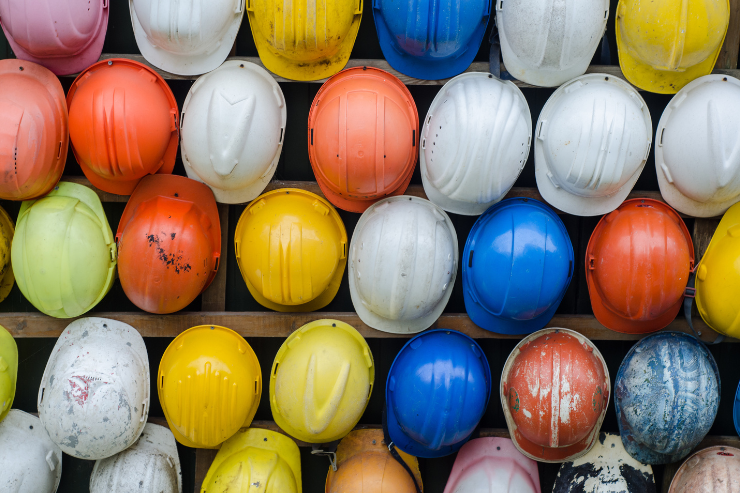
Construction sites have long been synonymous with hard hats and safety briefings.
However, with the industry witnessing a boom in complex projects and ever-evolving technologies, the landscape of construction safety is undergoing a significant shift.
Statistics speak for themselves: according to the Bureau of Labor Statistics, in 2022, the construction industry was responsible for almost 1 in 5 workplace fatalities.
Falls, slips, and trips contributed to 38.4% of these deaths.
Clearly, the traditional approach has not guaranteed a higher safety level, and the industry demands a more multifaceted approach.
This article will delve into the importance of following the established safety protocols, examine the causes of injuries and discuss the possible solutions for them.
Identifying construction safety risks is crucial for preventing accidents and ensuring the well-being of workers.
Here are some common safety risks found in construction sites and strategies for managing them:
Falls, Slips, and Trips: These are among the most common causes of injury in construction. Nearly half (47.4 percent) of all fatal falls, slips, and trips occurred within the construction sector.
They can be mitigated by using safety harnesses, ensuring proper scaffold construction, maintaining clean and clear work areas, and providing adequate lighting.
Moving Equipment and Vehicles: The interaction of heavy equipment and on-site workers poses significant risks.
Safety measures include training operators, establishing clear traffic routes, using spotters when moving equipment in congested areas, and maintaining regular communication through radios or hand signals.
Electricity and Electrical Hazards: Electrical risks can lead to shocks, burns, and electrocution.
Safety protocols include using ground-fault circuit interrupters, ensuring all electrical equipment is properly maintained, and training workers to handle electrical devices safely.
Noise and Hand-Arm Vibration Syndrome (HAVS): Long-term exposure to high noise levels can lead to hearing loss, while HAVS affects blood vessels, nerves, joints, and muscles, primarily due to prolonged use of vibrating tools.
Reducing these risks involves using ear protection, implementing quiet tools technology, and enforcing regular breaks for workers.
Manual Handling and Lifting: Improper handling and lifting can cause back injuries and muscle strains.
Training on proper lifting techniques, using mechanical aids, and encouraging teamwork are effective prevention strategies.
Collapsing Trenches and Excavations: Trench collapses are particularly deadly.
Safety measures include sloping, shoring, and shielding trench walls and conducting regular inspections before shifts.
Asbestos and Dust Exposure: Inhaling dust and fibers, especially asbestos, can lead to serious respiratory conditions.
It is crucial to use appropriate respiratory protection, wet down materials to minimize dust, and follow proper abatement procedures for asbestos.
Risk: Falls from improper scaffold use or inadequate fall protection.
Prevention: Ensure all scaffolding is erected, moved, and dismantled by competent persons. Utilize guardrails, safety nets, and personal fall arrest systems. Regularly inspect scaffolding and fall protection equipment for integrity.
Risk: Falls due to unstable ladders, improper setup, or cluttered stairways.
Prevention: Use ladders and stairways that comply with safety standards. Secure ladders at the top and bottom, and ensure stairways are well-lit and debris-free. Train workers on proper ladder use and carrying techniques.
Risk: Health hazards from exposure to chemicals and toxic materials.
Prevention: Implement a Hazard Communication Program, including Material Safety Data Sheets (MSDS) for all chemicals. Provide appropriate personal protective equipment (PPE) and training on handling hazardous substances. Ensure proper storage and labeling of all chemicals.
Risk: Collapses, toxic atmospheres, and asphyxiation in confined spaces or trenches.
Prevention: Require permits and specialized training for entry into confined spaces. Use air monitoring equipment to check for hazardous gases. Apply trench collapse prevention systems such as sloping, shoring, and shielding.
Risk: Injuries from operating heavy machinery without proper safeguards or training.
Prevention: Ensure all machinery is well-maintained and equipped with necessary safety devices. Train operators thoroughly and enforce the use of seat belts and other safety features. Establish and enforce exclusion zones where heavy equipment is operating.
Despite technological advancements, construction injuries, particularly falls, remain stubbornly high. This paradox stems from a confluence of factors.
New safety tools like drone inspections and wearable fall detection are exciting, but widespread adoption is limited by several factors.
Budget limitations, training needs, and resistance to disrupt established workflows.
Additionally, human error persists – fatigue, misjudgment, or neglecting safety protocols can still cause accidents.
Furthermore, the pressure to meet deadlines can incentivize shortcuts and neglect safety gear.
The inherent risks of construction – working at heights, with heavy machinery, and in ever-changing environments – present challenges that even advanced technology can’t fully address.
Unforeseen circumstances like weather or equipment malfunctions further complicate matters. However, the future is not bleak.
The construction industry can dramatically improve safety for workers by combining new technology with strong safety rules, regular training, and a focus on worker health.
A cornerstone of any safe construction project is a well-developed and rigorously followed Construction Site Safety Plan (CSSP). This plan is a roadmap for protecting workers from the inherent dangers of construction environments.
The first step involves a thorough hazard assessment. Here, safety professionals meticulously identify potential risks, considering everything from falling objects and electrical hazards to dangers posed by heavy machinery and excavation work.
Once identified, the CSSP outlines specific procedures for mitigating these risks, ensuring compliance with relevant OSHA regulations like CFR 1926.501 on Fall Protection, which mandates the use of guardrails, safety nets, or personal fall arrest systems for workers at heights exceeding six feet.
The plan should also detail emergency response protocols. This includes clear instructions for various emergencies, outlining evacuation procedures, first-aid protocols, and designated contact information for emergency responders.
Furthermore, a system for incident reporting and documentation is crucial. By recording and analyzing incidents, trends can be identified, allowing for targeted safety improvements and preventing similar occurrences in the future.
Ongoing worker training plays a vital role in a successful CSSP. This training should encompass a variety of topics, including a comprehensive review of construction safety regulations.
Workers must be thoroughly versed in proper use of Personal Protective Equipment (PPE), such as hard hats, safety glasses, and respirators, as mandated by OSHA regulations like CFR 1926.100 on Head Protection.
Regular safety drills and exercises further solidify this training. By simulating emergencies and practicing response protocols, workers gain the confidence and muscle memory necessary to react effectively in real-world situations.
Through a comprehensive CSSP that integrates hazard identification, emergency preparedness, incident reporting, and ongoing worker training, construction companies can foster a proactive construction site safety culture.
This culture prioritizes worker well-being, minimizes the risk of accidents, and ultimately creates a safer and more productive work environment for everyone involved.
The Occupational Safety and Health Administration (OSHA) provides specific guidelines and regulations to ensure construction sites remain safe for all workers.
These guidelines cover many practices, from using personal protective equipment (PPE) to properly maintaining equipment and organizing work sites.
Here is a breakdown of these guidelines as they apply to several critical aspects of construction safety:
Hard hats and helmets
Safety glasses and goggles
Earplugs and earmuffs
Respirators and masks
Steel-toed boots and safety shoes
Inspect equipment regularly for damage or wear
Provide training on equipment operation and maintenance
Ensure equipment is suitable for the task and worker
Keep walkways and work areas clear of debris and obstacles
Store materials and equipment properly
Ensure good housekeeping practices are followed
These regulations are critical for maintaining construction site safety standards and minimizing the risk of accidents on construction sites.
While prioritizing worker safety is an ethical imperative, it also translates to significant financial benefits for construction companies.
Here’s how:
According to the National Safety Council, the average cost of a workplace injury in 2022 was $40,000, and the expense for each death was $1,390,000. These costs encompass medical expenses, lost wages, and productivity losses.
By implementing effective safety measures and reducing injuries, companies can see a substantial decrease in workers’ compensation premiums.
A strong safety record directly impacts a company’s Experience Modification Rate (EMR), a key factor in determining insurance premiums. Lower EMRs translate to significant cost savings on general liability and commercial auto insurance.
Accidents and injuries disrupt project schedules and lead to costly delays. By minimizing these disruptions, companies can ensure projects stay on track and avoid the financial repercussions of missed deadlines.
A study found that marginalizing safety in workplaces end up with wage and productivity losses of $50.7 billion.
Workplace accidents can lead to lawsuits and fines. A proactive safety culture minimizes legal liabilities and protects a company’s reputation. In today’s competitive market, a reputation for safety can be a significant advantage when attracting and retaining top talent.
Beyond traditional methods, high-tech advancements are transforming construction safety. However, to unlock their full potential, robust communication and documentation are essential.
Documenting incidents (accidents, near misses) allows for root cause analysis and targeted interventions to prevent future occurrences. This data empowers safety professionals to tailor protocols effectively.
A clear system for reporting hazards and incidents, regardless of severity, is crucial. Encouraging worker participation fosters a safety culture and empowers them to be active participants. Prompt action on reported issues reinforces the importance of safety.
Leaders must prioritize safety and demonstrate genuine commitment. Encouraging worker participation, recognizing safe behavior, and utilizing buddy systems for new hires fosters a sense of ownership and accountability and equips new workers with the skills and knowledge for safe work.
As the construction industry evolves, integrating advanced technologies is key to enhancing construction site safety. The high number of injuries and illnesses highlights the need for a more comprehensive safety approach.
While traditional methods remain important, high-tech solutions like MobiClocks®️ offer significant improvements.
It employs advanced true face recognition technology to ensure accurate and secure employee identification. This feature prevents fraudulent time entries, ensuring only authorized personnel are on site, which is crucial in emergencies.
The system provides real-time data on employee attendance and location, which is crucial for immediate accountability and response during emergencies, improving overall safety.
MobiClocks®️ utilizes geo-fencing and GPS breadcrumbing to ensure employees are within designated job site boundaries, reducing unauthorized access and potential safety hazards.
In remote locations, MobiClocks®️’ offline punching capability ensures continuous time logging without internet connectivity, maintaining operational safety oversight.
The system’s comprehensive reporting capabilities provide insights into labor costs, productivity, and safety-related metrics, enabling proactive risk management.
MobiClocks®️ includes a flag alert system that notifies managers of irregularities, enhancing oversight and quickly addressing safety concerns; integrating these features, MobiClocks®️ significantly enhances operational efficiency and safety management, ensuring a safer work environment for all employees.
Embracing technologies like MobiClocks®️ is essential for advancing construction safety protocols and building a safer, more productive future.

There are a lot of ways to deal with no call, no show employees. The policies you enforce will depend on the type of manager you are.

Naturally, productivity and work ethics are positively and strongly correlated. There are many ways to set up a work environment where ethics are valued, and one of the most effective ways has proven to be guidance and empowerment. If you are ready to tak

Having an employee handbook is essential to the efficient operations of your business. In general, it contains all the procedures and policies that go on in your firm. It’s vital to have one, especially in construction companies, where logistics plays a h